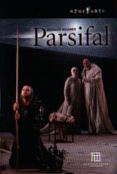 Festspielhaus, Baden-Baden
Festspielhaus, Baden-Baden
OPUS ARTE OA 0915 D
317’
Nikolaus Lehnhoff’s production of Parsifal was seen a few years back at ENO and this recording from Baden-Baden matches a highly intelligent approach with exceptional musical performances. Kent Nagano drives the action surprisingly quickly through the first two acts but finds all the reflective insight necessary to the third act. Waltraud Meier could hardly be bettered as Kundry, as dramatically effective, while silent, in the final act as she is thrilling in the second. Christopher Ventris is an unstrained Parsifal who gains authority as he grows. Matti Salminen adds touches of humour to Gurnemanz, adding warmth to a deeply felt humanity.
Choral singing is forceful throughout - for once one realises that these Knights of the Grail are just that - Knights - and their post communion singing has a dangerous edge to it, somewhere between Storm Troupers and Knights Templar. Orchestral sound is fired with particularly fine, ringing brass.
I was impressed with Nikolaus Lehnhoff’s production when I saw it at the London Coliseum and it is well worth revisiting. He eschews any hint of religious trappings, and there is no physical Grail. The Grail seems to be more the concept of inspired leadership, a sense of direction in a confused world. In Act One this leads back to a tight masculinity and militarism. By the final pages of the work Parsifal has broken through the circle of guilt and repression to lead those who will follow - along with Kundry - to a world which is united and untainted by the past. The railway line in the last act is inspired, hinting both at concentration camps, hopeless dead-ends and at the same time a clear way out.
It is beautifully lit but never simply pretty. For the Good Friday music the soloists are in the same grey, potentially bleak, landscape as much of the rest of the work, yet we are quickly led to understand that the meadows are beautiful not superficially but in their very essence. For the enlightened everything is beautiful - an understanding which reflects the strong Buddhist leanings within the work. Though this may upset those who see the work as essentially Christian it opens a far broader field of spirituality and those is far more inclusive. Hopefully ENO will revive the production as it is well worth seeing again.
As with most DVDs there is a Cast Gallery, illustrated synopsis and interviews with the director and soloists.
BH
